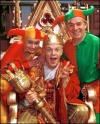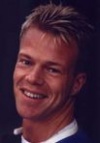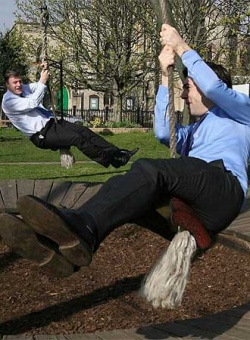Weaver's Week 2008-04-20
It is with great regret that we begin with news of the death of Mark Speight. It's been said that many children's television presenters hate kids' programmes, and want to move to a grown-up slot as soon as they could. Speight was an exception to test that maxim.
Mark Warwick Fordham Speight was born on 6 August 1965. His place of birth has variously been given as Trowbridge, Wiltshire; and Seisdon, Staffordshire. He was briefly a pupil at Tettenhall College, a public school in a suburb of Wolverhampton, but moved after a year to the nearby Regis Comprehensive. At this school, Speight was bullied daily for two years. "Suddenly, I was thrust into a comprehensive," he explained. "I turned up with a briefcase and a perfect uniform and, by the end of the first day, I had had most of it stolen." He countered the bullies by becoming the class clown and responding to their taunts with humour.
Though he fared badly at school, and left at 16, Speight went on to obtain a degree in Commercial and Graphic Art at Bilston Art School and the American College in London. He paid his way through a number of menial jobs, including some time spent as a male au pair. He designed the programme illustrations for Cameron Mackintosh's ill-fated West End musical production of Moby Dick in 1992, and played a small part on stage.
By this time, Speight had made something of a name for himself as a graphic artist, and it was while working on another show at the BBC that he heard about the auditions for Smart. In essence, the show was a continuation of Tony Hart's sequence of art programmes – Hartbeat (1984-93), Take Hart (1977-83), stretching all the way back to Vision On (1969-76). The show combined tips on making art with demonstrations by Speight and his co-presenters (Zoe Ball, Kirsten O'Brien), some comedy sketches, and a tour of pictures sent in by the viewers. A recurring feature showed Speight making a small picture, perhaps from scrunched up tissue paper, then a larger version on the floor using carpet tiles or larger household items. Speight would switch between the two when a buzzer sounded, swapping hats to show whether he was doing the big bit or the little bit.
Once his television career had begun, it didn't stop. His television style was like energy coming out of the set – he would bounce around the studio with his easily-identifiable white-blonde spiky hair. For ITV, Speight starred in a sky-blue jacket with cloud prints and a rubber blond wig that was Max Headroom incarnate on the Saturday morning cartoon-and-comedy show Scratchy & Co (1995-8). He also hosted the cartoon-based game show Name That Toon (1996-7); one of the shows in regional strand Take 7 (1996); he played the Abominable No Man in Timmy Towers (1997-2000) opposite Timmy Mallett; on biology show Insides Out (1999-2000); and hosted Beat the Cyborgs (2003-4). Contrary to the popular myth, Speight never provided the voice of the lift on Incredible Games. Speight wasn't just about entertainment. For the now-defunct Discovery Kids channel he wrote History Busters (RTS Children's Programme of the Year 2003), and he broke his finger while filming for Celebrity Wrestling (2005). This didn't happen when he was one of ten contestants on the Celebrity Gladiators challenge (1997).
Back on the BBC, Speight had hosted arts show On Your Marks (1998) with Tony Hart, and played the indecisive King of Much Jollity In The Mirth on surreal infants show See it, Saw it (1999-2001). While working on this programme, he met Natasha Collins, the pair began dating, found their love lasted after Collins was injured in a car accident in 2001, and eventually announced their plans for marriage.
Speight presented various Smart spin-offs – Smart On The Road (1999-2001) took the show around Britain to help youngsters with projects such as decorating a room, Smarteenies for younger children, and Smart Africa (2003) was location filming for the BBC's Africa Lives! season. Kirsten O'Brien and Speight trained as lumberjacks for an episode of Bring It On (2003), a show that set challenges for CBBC presenters.
Speight also made some programmes for older audiences – he had fronted a short series of documentaries on Africa, popped up on Channel 4 youth strand The Vibe, was a regular guest on ITV's This Morning, and put together a running strand about faith for The Heaven And Earth Show on BBC1.
He worked from time to time with Rolf Harris and in 2005 took part in Rolf On Art – The Big Events, in which he took over Trafalgar Square to create a giant version of John Constable's painting "The Haywain", live on national television. In follow-up programmes, artists from across the country created their version of Holbein's "Henry VIII", and remade Leonardo's "Mona Lisa" in the grounds of Edinburgh Castle.
Speight was a popular performer in pantomime, starring as Buttons in Cinderella at Broxbourne and Rickmansworth in recent years. He ran a touring art workship, Speight of the Art, and his charity work included a presidency of the Muscular Dystrophy Campaign – this rose from a one-off pavement art project with some children nominated by the charity. His next project was set to be a labour of love, where he would rescue orangutans from shysters in Borneo who trained them to kickbox. Speight's plan was to re-educate the primates not to fight each other.
Personal tragedy would prevent that plan from ever coming together. On 3 January, police found Natasha Collins dead in the bath at the couple's flat in North London, and Speight was briefly arrested (and cleared) on suspicion of murder and supplying controlled drugs. He resigned from Smart in February, saying that he was unable to return following his "tragic loss", and he moved in with Natasha's mother Carmen. Speight failed to meet Carmen for lunch on 7 April; his body was found six days later. It's not thought that anybody killed him.
Kirsten O'Brien led the tributes, saying that Speight was, "without doubt the funniest man I've ever known. Filming days were a joy as Mark would often have the crew and I doubled up with laughter and I think that showed on screen. Mark had a childlike enthusiasm for life which is what made him such a hit with young viewers.
"As a friend, Mark was gifted with making people laugh, he lifted your spirits, and his sense of the ridiculous was a delight. I'm proud to have had Mark in my life and am devastated at losing him in such a terrible way. All of his friends will miss him deeply. Mark could find light in the darkest situations for others. I'm only sorry he couldn't find it for himself. My thoughts are with his family."
Mark Speight is survived by his parents, a brother, and a sister.
Come Dine with Me
Granada for Channel 4, 8pm Thursday
If there's one show that has very quietly crept up on us, it's Come Dine With Me. The programme quietly slipped into the schedules at the start of January 2005, as half of the Lifestyle Hour that went out at 4pm on Channel 4. It was ready-made filler when Countdown was forced off the air that summer, and a new series aired in summer in 2006. Though C4's revised schedule has brooked little challenge since autumn 2005 – from 3.30 to 8pm is now a constant, modulo the chat-show at 5pm – Come Dine With Me refused to roll over and die. By word of mouth, the show became popular, and earned repeats on More4. They're now the channel's most popular programmes, knocking Deal or No Deal into a small red box. Now, the programme comes to prime-time.
The format is very simple: five strangers from the same part of the world throw dinner parties for each other. Everyone judges everyone else's cooking and hospitality, and awards marks out of ten. The person with the highest total mark wins £1000. Originally, Come Dine With Me ran across the week, with each half-hour show following one of the parties, and concluding with the Ceremony of the Awarding of the Marks, traditionally filmed in the back of a taxi on a dark and stormy night.
The prime-time version runs for just one hour, and has trimmed the cast from five people to four. It also reduces the time spent on each individual party in half. This ensures that the show has a cracking sense of pace, not moving so swiftly as to leave our flabbers slightly gasted, but not dwelling so slowly as to grow mould, or even grow cold.
On the surface, Come Dine With Me has to be a cookery show. It's about dinner parties, it invites the contestants to cook, surely most of the time will be spent on the food preparation. Not so: even on the daily show, there's not enough time to give full recipes and ingredients lists for the three dishes. On the prime-time show, they don't even attempt it, directing people to the website.
While there are shots of people cooking, and lots of discussion of what dishes work and what dishes don't work, this is almost a side-show to the programme's main thrust. At heart, Come Dine With Me is a people show. Over the course of the contest, we're introduced to four (or five) people, and see enough of them to flesh them out into three-dimensional characters. They joke, they criticise, they grow bitter. We see a little of the contestants' personal lives, and the prime-time show includes a Let's Nose Round Their House snippet, perhaps an acknowledgment to the domestic perfection presented in the first series.
Much of the programme's success comes from Dave Lamb's voice-over. He's witty and sarcastic, but uses just the right kind of wit and sarcasm, flipping almost effortlessly between laughing with the contestants and laughing at them. In that respect, he reminds us of the best parts of John Sachs's commentary on Gladiators: respectful, but not afraid to point out some of the absurdities.
As we'll see next week, not every light and undemanding show is hugely entertaining. At the end of the day, Come Dine With Me is a light and undemanding show, but a hugely entertaining light and undemanding show. While two-and-a-half hours is more of a commitment than we care to make for any Sunday afternoon, an hour on a Thursday night kicks the week-end off very nicely. In fact, the only disappointment we have is that the voice-over is provided by Dave Lamb (voice of the absurd on Radio 4 comedies such as Look Away Now) and we can't include a snark against the similarly-named but otherwise unrelated George Lamb (the best advertisement for Ken Bruce.) Bad news for us. Good news for the viewer.
This Week And Next
Also this week, we regret to report the death of Joanne Harris, aged 25. In 2000, she was in need of a heart-lung transplant, and a quarter of the required £250,000 was donated when Craig Phillips won that year's Big Brother. And, just to add to the black-edged writing, we must report the death of Ollie Johnston, the Disney animator who created Thumper.
Which brings us to University Challenge The Professionals, which had the butcher, the banker, and the greengrocer (or Dad's Army, as every BBC scheduler knows), and the Rocket Scientists suggesting that the Black Country was in Lancashire. We all know that the Black Country begins two streets from here, but it's somewhere around Dudley, West Bromwich, and Walsall. In the semi-final, the National Physical Laboratory know that capital-sigma means "summation", and the Hospital Consultants know that smallpox is history. Though the Consultants look like they're running away with the game until the final stanza, the NPL run out the winners, 180-145.
Ian Wright has resigned from the BBC, claiming that he was treated as a "comedy jester" between Alan Hansen, Alan Shearer, and Alan Lineker. Mr. Wright has already signed on for his next show, as the low-budget Jeremy Guscott on SKY's forthcoming version of Gladiators.
The new Glads have been unveiled to the UK's media. All of them are known to the producer (or, to be precise, her father) and are generally pictured exposing large amounts of skin. This week's edition of Have I Got News for You included a clip of Gladiators Headbanger and Burn, practicing for the new event "Hang Battle". It's a combination of the traditional Duel (you know, the one where they battle each other with oversized cotton-wool buds) and a swing, as each player is on a knotted rope and must hold their own balance while trying to knock the other off. New Gladiators will be coming to a children's playground near you soon, if you live in or near west London.
(Photo: Lewis Whyld via PA)
Who is interested in yet another piece of business propaganda? Not the BBC's viewers, it seems, for musical casting show I'd Do Anything was the most-seen programme in the week to 6 April; its 6.95m viewers were almost a quarter of a million more than The Apprentice garnered. ITV's top game show was either The World's Got Talent (4.9m) or the season finale of Duel (3.7m), depending on where one draws the line, and whether one wishes to include a third jackpot winner. University Challenge returned with its Professionals series, and it proved more popular than Noel's guessing game (2.6m to 2.4m). On Channel 5, Breaking Into A Well-Known Grocery Store ended with 1.2m.
Come Dine With Me continues to set records, recording its highest audience on More4, 965,000 saw the Sunday climax. Figures for America's Next Top Model were not available, but we do know that QI scraped past 500,000, while Pop Idle Us fell well short, on 465,000. Basil's Game Show and Best Of Friends both benefitted from the Easter break in parts of the UK, recording 165,000 and 195,000 viewers, respectively.
Coming up this week, the BAFTA Television Awards will honour Bruce Forsyth (BBC1, 8pm tonight). Before that, ITV invites us to Beat The Star With Vernon Kay (6.45), and ITV's also finally getting round to airing The Baron (10.35 Thursday, later in Wales).
To have Weaver's Week emailed to you on publication day, receive our exclusive TV roundup of the game shows in the week ahead, and chat to other ukgameshows.com readers sign up to our Yahoo! Group.






